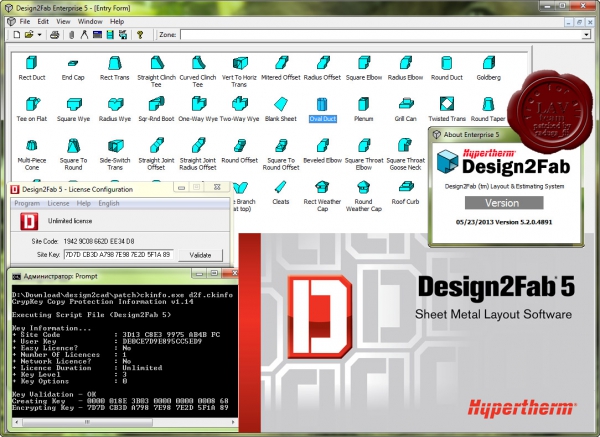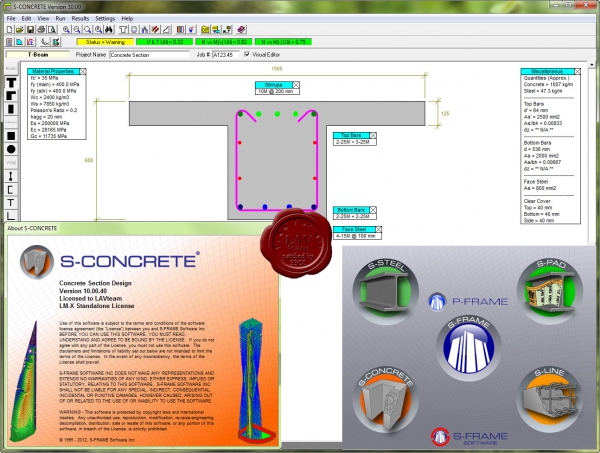|
 |
 Автор: Williams Автор: Williams
 Дата: 15 октября 2013 Дата: 15 октября 2013
 Просмотров: 2 345 Просмотров: 2 345 |
| |
Hypertherm Design2Fab v5.2.0.4891

Design2Fab is a stand-alone Hypertherm application for those creating HVAC duct, mechanical, kitchen, industrial, roofing, or specialty fitting layouts. Engineered to dramatically reduce the time it takes to develop and lay out flat patterns, Design2Fab provides you with the ability to create complex custom fitting layouts in minutes, not hours! You’ll be able to output and print plot files (HPGL) for manual cutting or output a DXF to a CNC cutting machine. DXF files can also be exported to ProNest, TurboNest, or NestMaster nesting software prior to cutting, allowing for optimal material utilization for jobs with multiple parts. |
| |
 Читать статью дальше (комментариев - 23)
Читать статью дальше (комментариев - 23)
| |
|
 |
 Автор: Williams Автор: Williams
 Дата: 13 октября 2013 Дата: 13 октября 2013
 Просмотров: 9 489 Просмотров: 9 489 |
| |
S-FRAME Structural Office 2012 v10:
S-STEEL, S-PAD, S-FRAME, S-CONCRETE, S-LINE, P-FRAME

Structural Office R10 is a suite of structural analysis and design software with powerful BIM/CAD links, is designed to increase productivity and collaboration among projects' stakeholders. The various components of Structural Office may be purchased separately or bundled together within Structural Office, and with the exception of S-STEEL Design, they can all operate as stand-alone applications as well.
S-STEEL - design of steel structures including steel members, plate girders, tapered plate girders and more. Includes code checking, auto-design and optimization to multiple design codes on a complete structure or just part of a structure. S-STEEL is fully integrated with S-FRAME.
S-PAD - a standalone steel design and optimization product. Quickly check columns, beams or braces without the need to build a detailed model for the complete structure. Built with the structural engineer consultant in mind.
S-FRAME - a complete structural modeling, analysis, and design environment. S-FRAME features numerous productivity tools, advanced analyses, a variety of material models, flexible load combination methods, fast and accurate solver technology all bundled within a powerful and intuitive user interface.
S-CONCRETE - comprehensive section design and detailing tool of reinforced concrete beams, columns and walls. Its powerful graphical output capabilities provide immediate feedback to the engineer as design parameters are changed. S-CONCRETE is integrated with S-FRAME.
S-LINE - an intuitive yet powerful standalone application for the analysis, design and detailing of continuous reinforced concrete beams. S-LINE supports code checking and automated design and detailing to multiple design codes for a variety of section types.
P-FRAME - 2D structural analysis tool.
|
| |
 Читать статью дальше (комментариев - 7)
Читать статью дальше (комментариев - 7)
| |
|
 |
 Автор: Williams Автор: Williams
 Дата: 7 октября 2013 Дата: 7 октября 2013
 Просмотров: 6 859 Просмотров: 6 859 |
| |
Graitec Advance Suite 2014 x86+x64
Graitec Advance - программный комплекс проектирования металлоконструкций.
Advance Concrete был разработан специально для профессионалов в области проектирования железобетонных конструкций, нуждающихся в комплексном, удобном в использовании и полностью интегрированном в AutoCAD программном обеспечении. Программа автоматизирует процесс создания чертежей общих видов, опалубочных чертежей, чертежей армирования и ведомостей материалов.
Advance Steel был разработан специально для профессионалов в области строительного проектирования, нуждающихся в комплексном и полностью интегрированном решении на базе AutoCAD. Advance Steel автоматизирует полный цикл проектирования металлоконструкций (создание детальной трехмерной информационной модели конструктивного решения, деталировку узлов, разработку комплекта рабочих чертежей марок КМ и КМД, получение соответствующих спецификаций и ведомостей материалов по ГОСТ), а также вывод данных на станки с ЧПУ.
Advance Design was specifically developed for industry professionals that require a superior solution for the structural analysis and design of Reinforced Concrete and Steel structures according to the latest versions of Eurocodes (EC0, EC1, EC2, EC3 and EC8). Advance Design features include easy modeling, a powerful FEM analysis engine, top-level design wizards, automated post-processing of results and automated reports. Achieve a new level of computer-assisted engineering with Advance Design. |
| |
 Читать статью дальше (комментариев - 38)
Читать статью дальше (комментариев - 38)
| |
|
 |
 Автор: Williams Автор: Williams
 Дата: 4 октября 2013 Дата: 4 октября 2013
 Просмотров: 3 747 Просмотров: 3 747 |
| |
TNO Effects v9.0.16.8022
Effects is software for safety- and hazard analysis.
Effects is advanced software to assist you in performing safety analysis for the (petro) chemical industry throughout the whole chain, from exploration to use. It calculates the effects of the accidental release of hazardous chemicals, allowing you to take steps to reduce the risks involved. |
| |
 Читать статью дальше (комментариев - 15)
Читать статью дальше (комментариев - 15)
| |
|
 |
| ПОИСК ПО САЙТУ |
 |
|
 |
| КАЛЕНДАРЬ | | |
 |
| « Октябрь 2025 » |
|---|
| Пн | Вт | Ср | Чт | Пт | Сб | Вс |
|---|
| | 1 | 2 | 3 | 4 | 5 | | 6 | 7 | 8 | 9 | 10 | 11 | 12 | | 13 | 14 | 15 | 16 | 17 | 18 | 19 | | 20 | 21 | 22 | 23 | 24 | 25 | 26 | | 27 | 28 | 29 | 30 | 31 | |
|
 | |
| |
|